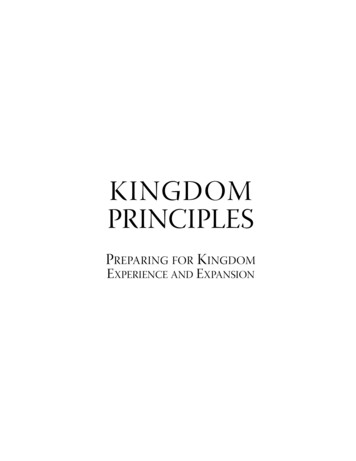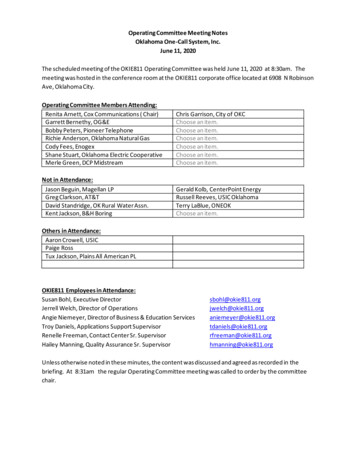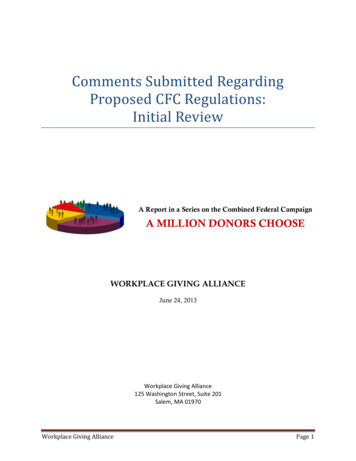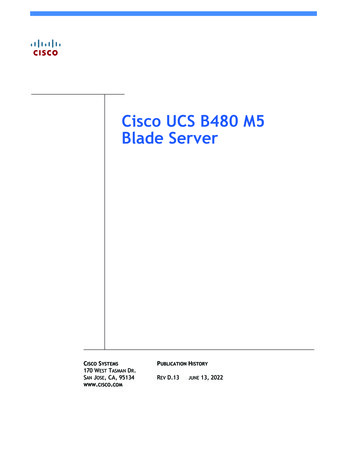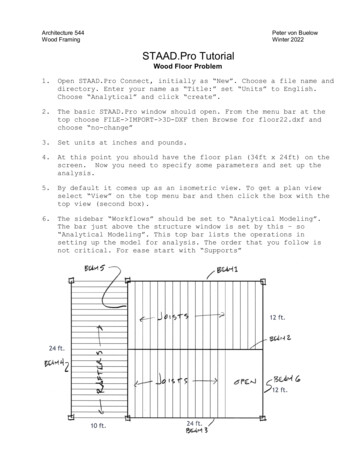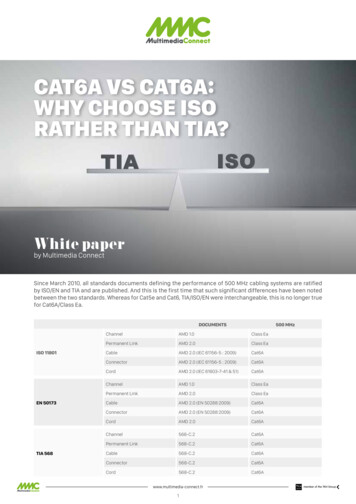
Transcription
CAT6A VS CAT6A:WHY CHOOSE ISORATHER THAN TIA?White paperby Multimedia ConnectSince March 2010, all standards documents defining the performance of 500 MHz cabling systems are ratifiedby ISO/EN and TIA and are published. And this is the first time that such significant differences have been notedbetween the two standards. Whereas for Cat5e and Cat6, TIA/ISO/EN were interchangeable, this is no longer truefor Cat6A/Class Ea.DOCUMENTSISO 11801EN 50173TIA 568500 MHzChannelAMD 1.0Class EaPermanent LinkAMD 2.0Class EaCableAMD 2.0 (IEC 61156-5 : 2009)Cat6AConnectorAMD 2.0 (IEC 61156-5 : 2009)Cat6ACordAMD 2.0 (IEC 61603-7-41 & 51)Cat6AChannelAMD 1.0Class EaPermanent LinkAMD 2.0Class EaCableAMD 2.0 (EN 50288:2009)Cat6AConnectorAMD 2.0 (EN 50288:2009)Cat6ACordAMD 2.0Cat6AChannel568-C.2Cat6APermanent at6ACord568-C.2Cat6Awww.multimedia-connect.fr1
The ISO Cat6A was intended by the standards committees to provide a Shannon capacity of 40 Gbits/s, and theIEEE is already working on connection possibilities higher than 10 Gbits/s on twisted pair systems in RJ45 throughIEEE 802.3 ba.Recap of SHANNON’s theorem:In an Ethernet type LAN, the allowable theoretical throughput (C) in the bandwidth is defined by the followingformula:C BW * LOG2 (1 SNR)BW Channel BandwidthSNR Signal to Noise RatioMAJOR DIFFERENCES BETWEEN ISO AND TIA CAT6ANEXT : main parameter for network performanceThe main difference concerns the NEXT values on the connectors. The difference between the two standards is3 dB at 500 MHz.TIA tolerates twice as much interference at 500 MHz as ISO.As the graph below shows, this difference is very marked on the connector values:Limite NEXT - ConnectorA representation of these values on the complete link with a comparison between 10 G, TIA Cat6A and ISO Cat6A.Limite NEXT - Channelwww.multimedia-connect.fr2
Return Loss : no difference here between the standardsThe Return Loss values are identical for the ISO, EN and TIA documents, so this is not the differentiating parameter.Effect on a complete linkAs a consequence of these differences, the acceptance procedure can be surprising, with a negative resultdisplayed for measurements performed in Class Ea, with Cat6A components.Comparison of measurement with commercially available Cat6A components in accordance with TIA:Measurement performed on an 18meter link with commercially availableTIA Cat6A components.Test in permanent link in accordance withTIA 568-C.2 Cat6ACORRECTThe same link is re-certified inaccordance with the ISO Class Ea (LowIL because link is in progress)Test in permanent link in accordance with:ISO CLASSE EaFAILwww.multimedia-connect.fr3
Components defined by the TIA standard TIA can FAIL the ISO System test:Cat6A connectorCord Cat6A Cord Cat6ACat6A cableEN 50173Cat6A connectorCord Cat6A -Cat6A cableCat6A connectorTIA 568ISO CLASS EA PERMANENT LINK Cat6A cableISO 11801ISO CLASS EA CHANNELCord Cat6A -Alien CrosstalkAlien Crosstalk: interference of cables within a bundle. This measurement parameter is mandatory for Cat6A andis treated differently in accordance with the documents.For TIA, Alien Crosstalk must be measured in the field in all possible situations. The measurement must beperformed with a level IV tester.For ISO, Alien Crosstalk and its parameters (ANEXT, PSANEXT, PSAACR-F, etc.) meet two different requirements:- Laboratory reference test : Must be performed by manufacturer to prove that its system is compliant- Field test : Must be performed on-site to confirm compliance after installation.TRANSMISSION PARAMETERSLABORATORY REFERENCE TESTSFIELD TESTSMandatoryMandatoryReturn lossInsertion lossesMandatoryMandatoryPair-to-pair ir-to-pair edPair-to-pair Continuous loop resistanceMandatoryMandatoryVariation of continuous loop resistanceMandatoryFor informationPropagation delayMandatoryCalculatedDelay skewMandatoryCalculatedCoupling attenuationMandatoryFor informationPS ANEXT*MandatoryMandatory by samplingPS ANEXTavgCalculatedCalculatedPS AACR-F*MandatoryMandatory by samplingPS AACR-Favg or informationFor informationLengthImportant: ISO mentions the possibility of not measuring these Alien Crosstalk parameters as soon as the cablingsystem coupling attenuation exceeds a certain value.www.multimedia-connect.fr4
What standard for Cat6A networks in Europe?From a ‘legal’ point of view, only ISO has official legitimacy.In addition, this standard has a higher requirement which guarantees a better performance and the possibilitythat the installation can support 40 Gbits/s communication protocols (probably over short lengths).Lastly, ISO offers a solution for field tests of Alien Crosstalk, taking account of the performance of the shieldedcabling systems.With EIA/TIA, on the other hand, measurement of Alien Crosstalk is mandatory. It is noted that these long andexpensive measurements are rarely performed in the field. As a result, these installations are formally ‘nonstandard’.ISO therefore constitutes the only current applicable standard for Cat6A in Europe.It is necessary to be vigilant in writing specifications and in checking acceptance procedures.THE MULTIMEDIA CONNECT SOLUTION: ISO CAT6A CERTIFIEDCOMPONENTExcept for the North American territory, the standard reference document is ISO 11801. Multimedia Connect nowproposes an international system with a certified component and guarantee - surely one of the best in the world.MK6AFS: the ISO Cat6A certified Multimedia Connect connectorCurrently, the MK6AFS connector is the only connector certified (by Delta Electronics in Denmark) on the adoptedversion of standard ISO 11801 amendment 2.0.www.multimedia-connect.fr5
Short link: Which standard to choose?In traditional cabling infrastructures, short lengths of less than 15 meters are not authorised because the shortdistance between the two ends of the link generates reflection phenomena, which often entail negative resultsin field tests.Some installers implement excess lengths of cable to extend the distance beyond 15 meters but fortunately themajority of the links in office installations exceed this limit.For Data Centers, however, there are very many links shorter than 15 meters. They represent between 60 % and80% of links, depending on the site configuration. It is therefore essential to be able to use cabling systems withperformance that allows a positive field test on these short lengths. Category 6A/Class Ea is therefore the mostappropriate standard level for Data Center applications.The Multimedia Connect cable is also componentcertified by Delta Electronics. It is used to implementhigh-quality installations, particularly over shortlengths with the highest requirements.The Multimedia Connect links also comply with thesame standard for lengths shorter than or equal to15 meters.‘Component’ certified RJ45 cordsThe Multimedia Connect LED (end marking) technologycords are component certified by the GermanLaboratory GHMT. They have light-up identificationmarking by LED moulded into the sleeve.www.multimedia-connect.fr6
System made immune to Alien CrosstalkThe Multimedia Connect shielded cabling system has excellent coupling attenuation. It is notnecessary to test Alien Crosstalk on-site, therefore. Average value of 60 dB shielded systems(1 MHz F 1000 MHz)Each installation implemented using Multimedia Connect products guarantees compliancewith the standard in relation to Alien Crosstalk. As the ISO indicates, measurements wereperformed in the laboratory:Complete system measured up to 700 MHz (extrapolated limits)The Multimedia Connect system implemented in this way with individually certified components allows the Cat6Alimits to be exceeded and throughputs beyond the current 10Gigabits/s to be envisaged.CONNECTORCABLECORDLENGTHNEXT MARGINRESULTSMK6AFSF555-4SHCORD6A02LED40 m5.0 dBPASSMK6AFSF555-4SHCORD6A02LED80 m4.9 dBPASSMK6AFSF555-4SHCORD6A02LED40 m4.4 dBPASSMK6AFSF555-4SHCORD6A02LED80 m4.3 dBPASSwww.multimedia-connect.fr7
The links even support frequencies higher than 700 MHz, potentially allowing throughputs close to 40 Gbits/s.www.multimedia-connect.fr8
Since March 2010, all standards documents defining the performance of 500 MHz cabling systems are ratified by ISO/EN and TIA and are published. And this is the first time that such significant differences have been noted between the two standards. Whereas for Cat5e and Cat6, TIA/ISO/EN were interchangeable, this is no longer true for Cat6A .
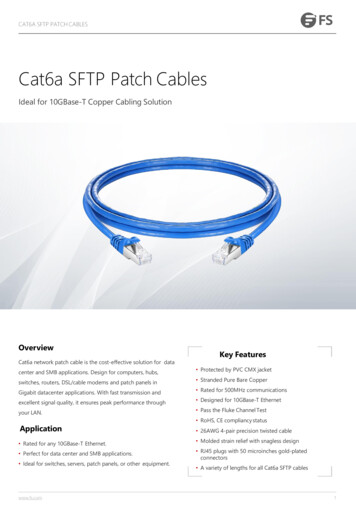

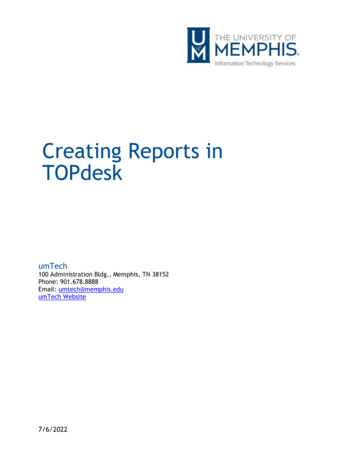
![[Page 1 – front cover] [Show cover CLEAN GET- AWAY 978-1 .](/img/13/9781984892973-6648.jpg)

